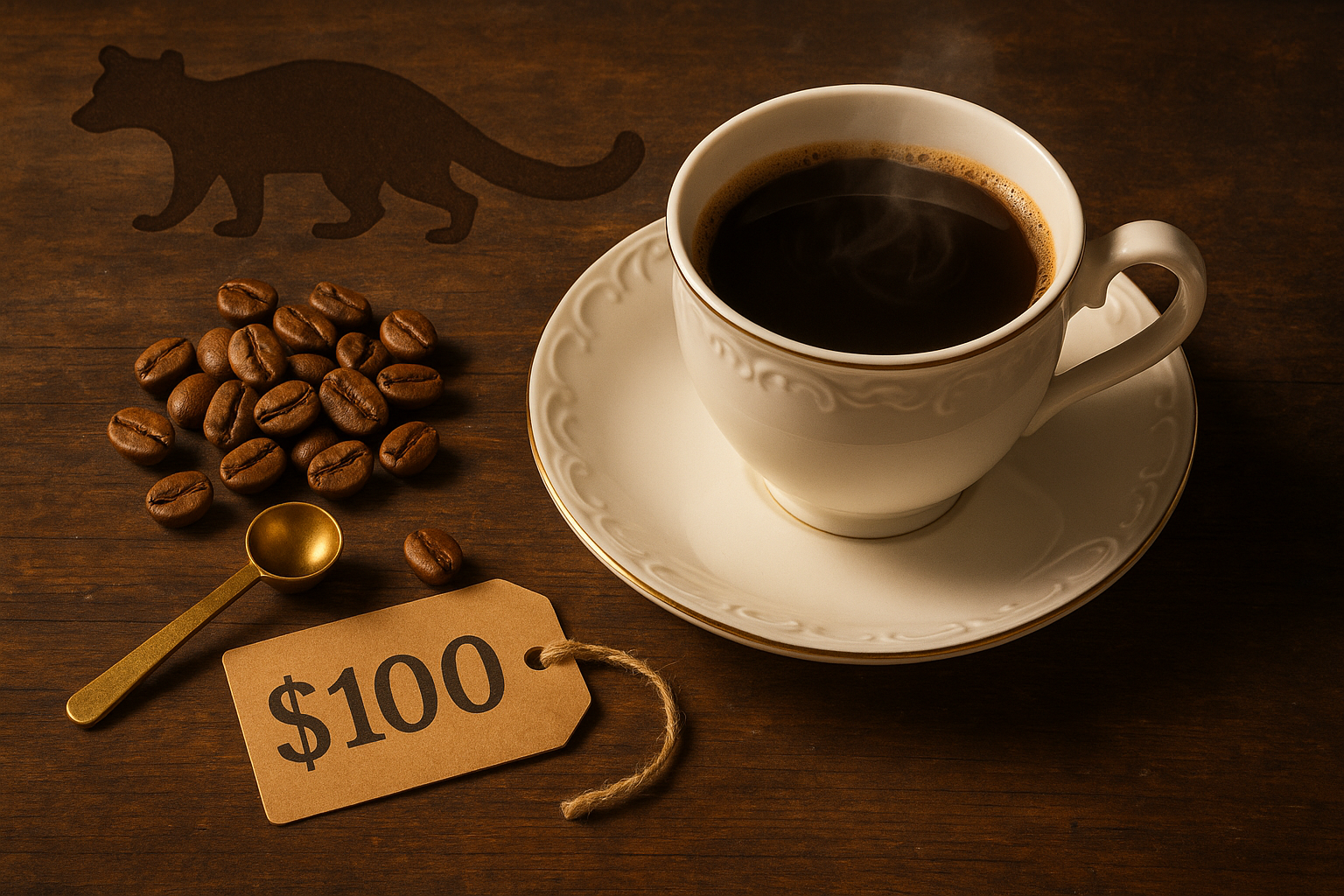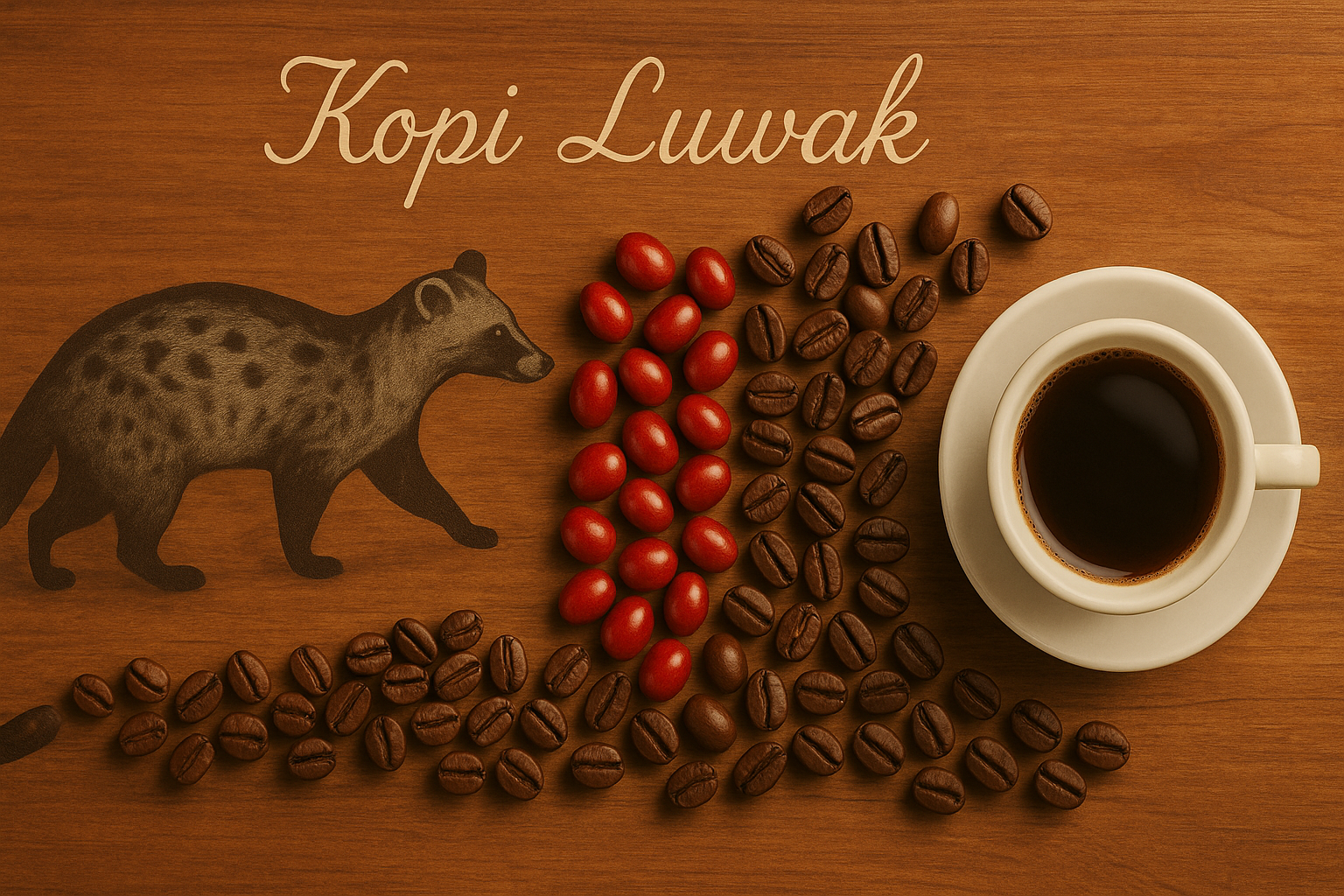Introduction: The Economics of Extraordinary Coffee
My name is Marco, and in my twenty years of coffee industry experience, no product has generated more questions, controversy, and confusion than Kopi Luwak. When customers discover that authentic Kopi Luwak can cost $600 per pound—more than many people's monthly coffee budget—the inevitable question follows: "Why is it so expensive?" The answer is far more complex than most people realize.
Having traveled to Indonesia, visited civet farms, worked with exporters, and witnessed both legitimate and fraudulent operations firsthand, I can tell you that Kopi Luwak's pricing reflects a perfect storm of genuine rarity, production complexity, market manipulation, and consumer psychology. Understanding these factors is crucial for anyone considering this investment.
Current Market Pricing (2025)
- Authentic Wild Kopi Luwak: $400-600 per pound
- Cage-Raised (Ethical Farms): $200-400 per pound
- Commercial Grade: $100-200 per pound
- Suspected Counterfeit: $30-80 per pound
- Tourist Market: $20-50 per pound
The Fundamental Factor: Genuine Rarity
The primary driver of Kopi Luwak's extreme pricing is legitimate scarcity. Unlike regular coffee, which can be cultivated and harvested at will, authentic Kopi Luwak depends on the eating habits and digestive processes of wild Asian palm civets—a factor completely outside human control.
Production Reality
1Wild Civet Limitations
A single wild civet produces approximately 1-1.5 kg of processed beans annually. With declining wild populations due to habitat loss, the actual number of productive civets continues to shrink. Current estimates suggest fewer than 10,000 wild civets contribute to the global Kopi Luwak supply.
2Collection Challenges
Finding civet droppings in dense jungle terrain is labor-intensive work requiring local expertise. Collectors must navigate difficult terrain, often at dawn when tracks are fresh, and compete with other collectors for limited deposits. A full day's search might yield only 100-200 grams of beans.
3Processing Complexity
Each bean must be individually cleaned, sorted, and verified. The fermentation process during digestion creates variations in bean quality, with only 60-70% meeting export standards. This additional sorting further reduces the final yield.
Annual Production Reality
Global authentic Kopi Luwak production is estimated at just 500-700 pounds annually. To put this in perspective, Starbucks processes more coffee in a single hour than the entire world produces of authentic Kopi Luwak in a year.
Market Forces Driving Premium Pricing
Supply Chain Economics
The journey from jungle to coffee cup involves multiple intermediaries, each adding their markup to cover costs, risks, and profits:
Typical Price Breakdown (Per Pound)
- Collector Payment: $50-80 (Local Indonesian rate)
- Processing & Cleaning: $30-50
- Local Exporter Margin: $40-60
- International Importer: $80-120
- Distributor/Retailer: $150-300
- Final Retail Price: $400-600
Luxury Market Psychology
The Veblen Good Effect
Kopi Luwak exhibits characteristics of a Veblen good—a luxury item where demand increases as price increases. The extreme price itself becomes part of the product's appeal, creating a self-reinforcing cycle where higher prices signal greater exclusivity and desirability.
This psychological factor explains why some producers intentionally maintain high prices even when they could potentially reduce costs. The price premium becomes integral to the product's luxury positioning.
The Authenticity Crisis: How Fraud Affects Pricing
Perhaps no factor complicates Kopi Luwak pricing more than widespread counterfeiting. Industry experts estimate that 80-90% of coffee sold as "Kopi Luwak" is either completely fake or heavily adulterated with regular coffee beans.
The Counterfeit Problem
- Scale: For every pound of authentic Kopi Luwak, 10-15 pounds of fake product enter the market
- Methods: Regular beans treated with artificial flavoring, mixing authentic with regular beans
- Impact: Creates price confusion and market distrust
- Detection: Laboratory testing required for verification
Why Authentic Producers Charge Premium
1Documentation Costs
Legitimate producers must invest in extensive documentation, traceability systems, and third-party verification to prove authenticity. These costs can add $50-100 per pound to production expenses.
2Reputation Protection
Established authentic producers maintain premium pricing to differentiate from counterfeits. Lower prices would signal potential fraud to knowledgeable consumers, paradoxically reducing demand.
3Limited Distribution
Authentic producers typically work with select, verified distributors rather than mass market channels, maintaining exclusivity but limiting volume sales that could reduce per-unit costs.

Ethical Considerations and Price Premiums
The emergence of cage-raised civet farms has created an ethical dilemma that directly impacts pricing structure. While these operations can produce larger quantities, they raise significant animal welfare concerns that ethical consumers are willing to pay premiums to avoid.
Wild vs. Cage-Raised Pricing
Ethical Pricing Tiers
- Wild-Sourced (Ethical): $400-600/lb - Premium for verified wild collection
- Semi-Wild (Free Range): $250-400/lb - Civets in natural habitat with minimal intervention
- Cage-Raised (Commercial): $100-250/lb - Higher volume, ethical concerns
- Battery Cage Operations: $50-150/lb - Mass production, serious welfare issues
Ethical Considerations
Many commercial Kopi Luwak operations keep civets in battery-cage conditions, force-feeding them coffee cherries and causing significant stress. Ethical consumers pay premiums for verified wild-sourced or humanely-raised alternatives, driving up prices for responsible products.
Hidden Production Costs
Beyond the obvious factors, numerous hidden costs contribute to Kopi Luwak's extreme pricing:
Quality Control and Testing
1Laboratory Verification
DNA testing and chemical analysis to verify authenticity costs $200-500 per batch. For small lots, this can add $50-100 per pound to production costs.
2Specialized Storage
Kopi Luwak requires climate-controlled storage to preserve its unique flavor profile. Specialized facilities and handling add approximately $20-30 per pound to logistics costs.
3Insurance and Risk
High-value cargo requires specialized insurance. Shipping costs can reach $100-200 per pound due to security requirements and specialized handling.
4Legal and Compliance
CITES permits, health certificates, and import/export documentation can cost $500-1000 per shipment. For small batches, this significantly impacts per-pound costs.
Market Comparison: Kopi Luwak vs. Other Luxury Coffees
To understand Kopi Luwak's pricing, it's helpful to compare it with other luxury coffee products:
Luxury Coffee Price Comparison (Per Pound)
- Kopi Luwak (Authentic): $400-600
- Black Ivory Coffee: $1,100-1,500
- Hacienda La Esmeralda Geisha: $600-1,000
- Jamaica Blue Mountain: $80-150
- Hawaiian Kona (Extra Fancy): $60-100
- Specialty Single-Origin: $20-50
- Commercial Grade: $3-8
Market Position Analysis
Kopi Luwak occupies a unique position in the luxury coffee market. While not the most expensive (Black Ivory Coffee holds that distinction), it's the most recognized luxury coffee brand globally, benefiting from first-mover advantage and extensive media coverage.
The Value Proposition: Is It Worth the Price?
The question of whether Kopi Luwak justifies its price depends entirely on what you're buying and why:
Objective Value Assessment
Value Factors
- Flavor Uniqueness: Genuine Kopi Luwak has a distinctive smooth, low-acid profile
- Rarity Experience: You're tasting something fewer than 1,000 people worldwide consume annually
- Cultural Significance: Participating in a centuries-old Indonesian tradition
- Conversation Value: The story and experience often outweigh the taste for many consumers
When the Price Makes Sense
1Special Occasions
For once-in-a-lifetime experiences, celebrations, or unique gifts, the premium can be justified as entertainment/experience cost rather than pure coffee consumption.
2Coffee Collecting
Serious coffee enthusiasts often view authentic Kopi Luwak as a "holy grail" experience worth the investment for completeness of their coffee journey.
3Business Entertainment
In certain business contexts, serving authentic Kopi Luwak can demonstrate sophistication and attention to detail that justifies the cost as a business expense.
Smart Buying: Getting Value for Your Investment
If you decide to purchase Kopi Luwak, these guidelines will help ensure you get authentic product and reasonable value:
Authenticity Verification
- Certification: Look for third-party authentication certificates
- Price Floor: Anything under $300/lb is highly suspect
- Source Documentation: Reputable sellers provide collection location and date information
- Small Quantities: Authentic producers typically sell in 100-250g packages
- Bean Appearance: Authentic beans show irregular sizes and visible processing marks
Money-Saving Tips
- Buy Direct: Purchase from verified Indonesian exporters when possible
- Group Purchases: Split larger quantities with other coffee enthusiasts
- Timing: Prices tend to be lower during harvest season (May-September)
- Sample First: Many legitimate sellers offer small sample sizes
Conclusion: Understanding the True Cost
After two decades in the coffee industry, I can say that Kopi Luwak's extreme pricing reflects a complex web of genuine rarity, production challenges, market psychology, and unfortunately, widespread fraud. The legitimate product commands high prices because it truly is one of the world's rarest consumable items.
However, the market's fragmentation between authentic and counterfeit products means that pricing alone doesn't guarantee quality or authenticity. The most expensive Kopi Luwak isn't necessarily the best, and the cheapest is almost certainly not authentic.
Final Assessment
Kopi Luwak's pricing is justified for the authentic product when viewed as an experiential luxury rather than everyday coffee. The combination of genuine scarcity, production complexity, and market positioning creates a perfect storm for extreme pricing. Whether it's "worth it" depends entirely on your personal values, budget, and what you hope to gain from the experience.
My recommendation: If you're curious about Kopi Luwak, try it once from a verified authentic source as a special experience. Understand that you're paying for rarity, story, and exclusivity as much as flavor. But don't expect it to transform your daily coffee routine—there are many excellent coffees at 1/10th the price that will provide superior daily enjoyment.
The world of luxury coffee offers many alternatives that provide exceptional quality and unique experiences without the ethical concerns and extreme pricing of Kopi Luwak. Explore widely, buy responsibly, and remember that the best coffee is ultimately the one you enjoy most.
May your coffee investments bring both pleasure and understanding of this fascinating industry.
